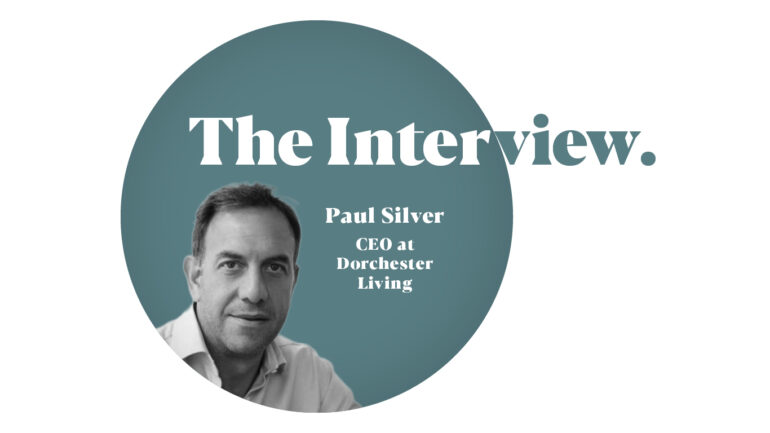Paul Silver, CEO at Dorchester Living, discusses his transition from finance to regeneration, and how long-term planning, sustainability and community needs shape the company’s approach to development.
To begin, tell give us a brief introduction to yourself and your career thus far.
I trained as a Chartered Accountant and began my career in finance as a strategic consultant at Ernst & Young. I then moved into mergers and acquisitions, advising the housebuilding sector at Deutsche Bank and Citigroup.
I’ve always believed in the legacy of place – how the built environment can shape lives over generations. My experience in the housebuilding and construction sectors gave me both the commercial foundation and the conviction to steer the business in a new direction. That led to the creation of Dorchester Regeneration and Dorchester Living.
I set up Dorchester Regeneration in 2003, helping to reposition the business toward new-build developments and establishing its project finance arm, which acted as a joint venture partner to many of the UK’s largest housebuilders.
In 2008, we had the opportunity to acquire Heyford Park, a former RAF base in Oxfordshire, from Persimmon and Taylor Wimpey. What started as a bold regeneration vision has since become a thriving community with 1,200 homes delivered at Heyford Park so far, along with a range of community amenities, including Heyford Park School, a hotel, restaurant, pharmacy, a Sainsbury’s Local and a growing commercial quarter.
Building on that success, we’ve also expanded into Hampshire, where we’re transforming part of the former Prince Philip Barracks at Bordon into a vibrant new neighbourhood. There, we’re delivering 2,400 homes, new schools, green spaces and extensive community infrastructure as part of one of the South East’s most ambitious regeneration projects.
I am focused on steering the next phase of our masterplan and championing a holistic approach to placemaking – one that balances innovation with social value.
As the head of the Heyford Park delivery team and Dorchester Living, how do you balance long-term vision with the day-to-day realities of delivering large-scale regeneration projects?
Having the vision to look at development as a whole and thinking long-term. This approach supports integrated planning and creates places that are not just functional but sustainable and well-connected from the outset. There’s always going to be challenges along the way and these are inevitable in a project of this scale.
Of course, challenges come with any project of this scale. What’s important is staying flexible, responding to feedback, and working closely with the team to make day-to-day decisions that don’t lose sight of the bigger picture. It’s about holding onto the vision while still being realistic about what’s needed in the short term.
Heyford Park is a flagship example of community-led regeneration. What does “community-led” mean to you in practice, and how has that informed your approach?
For me, community is the starting point. Places don’t thrive without people. Heyford Park has grown into a well-rounded neighbourhood – with everything from starter homes and bungalows to shops, schools and business space.
It’s easy in this industry to get caught up in numbers. But we try to focus on what matters – seeing families settle in, supporting local businesses, and helping a genuine sense of place grow over time. That takes listening, learning and improving as we go.
One recent example is a consultation we ran with teenagers at Heyford Park. We wanted to hear directly from young people about what they felt was missing. As a result, we’re now including things like a pump track, outdoor table tennis, football tables and mini libraries. It’s not about ticking boxes – it’s about creating places that reflect what people actually want and need.
You were a strong advocate for establishing Dorchester Group as a Registered Social Landlord. What inspired that move, and what has been the impact so far?
I feel strongly that we need to provide homes for everyone – whether that’s private sale, shared ownership or affordable rent. Getting on the property ladder is increasingly difficult, so we need to offer a full range of options.
But just as importantly, the quality of the home and service shouldn’t depend on the tenure. That’s a core principle for us – every resident should have the same high-quality design and customer care, no matter how they buy or rent.
With 30% of future homes in the regeneration now designated as affordable, how do you strike a balance between commercial viability and social value?
Social value is central to everything we do – and commercial viability needs to support that, not dictate it. We don’t treat affordable housing as a tick-box exercise or push it to the edges. It’s fully integrated into our masterplans.
We ‘pepper pot’ different tenfures throughout the development, so you don’t see obvious divisions – it’s one community, not separate parts.
And that builds its own value, creating a place that everyone is proud to call home, where community and the needs of the local people come first.
With plans to expand Heyford Park to 9,000 homes, how are you integrating sustainability and climate resilience into the development?
In recent weeks, the UK has experienced its hottest June in over 60 years and there’s growing concern on the effects of climate change on people’s everyday lives from where they live to where they work. At Heyford Park, we are committed to responding to this climate challenge with ambition and action.
We have set a bold target to become the UK’s first energy surplus town through wind, solar and ground source heat. It’s an ambitious goal, but one we are passionate about achieving. Sustainability is central to our approach. We are already implementing measures to ensure our developments are future-proofed, environmentally responsible and climate-resilient.
There’s a long journey ahead. We’re actively adapting to new regulations such as the Future Homes Standard and Biodiversity Net Gain legislation, making sure sustainability is embedded in the design of developments.
What are the biggest challenges developers are facing today – from planning policy to labour and materials?
Navigating the planning system remains a major challenge. It’s complex and slow, which can really delay delivery.
Market conditions haven’t been easy either – they’ve tested the industry’s resilience. We’ve had to stay flexible, structure our deals carefully and work closely with landowners to make sure we keep momentum going.
Looking ahead, what do you think will define success for housebuilders in the next decade – beyond just unit delivery numbers.
The UK government announced a major housing renewal and has made some positive noise aimed at addressing the housing crisis and supporting housebuilders has been the topic of discussion since they came into Government a year ago. But with this comes greater opportunity, this is a redefining moment for housebuilders.
Success will go far beyond hitting the 1.5 million homes target. It will be about creating thriving communities, increasing employment opportunities, transforming energy systems and improving local infrastructure.
There’s also huge potential in embracing new technologies, especially around clean energy. The next wave of housing will be defined not just by how many homes we build – but how smart, sustainable and resilient they are.




